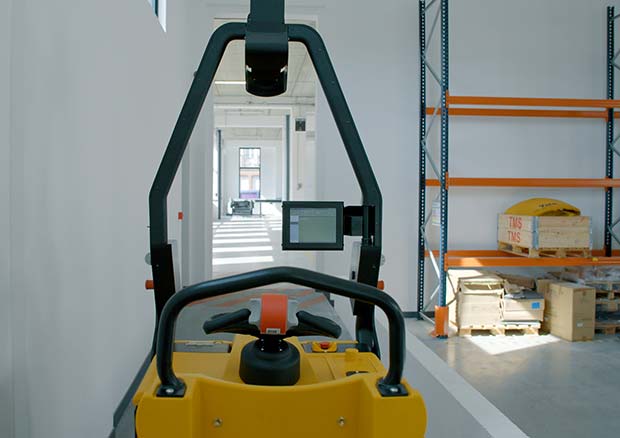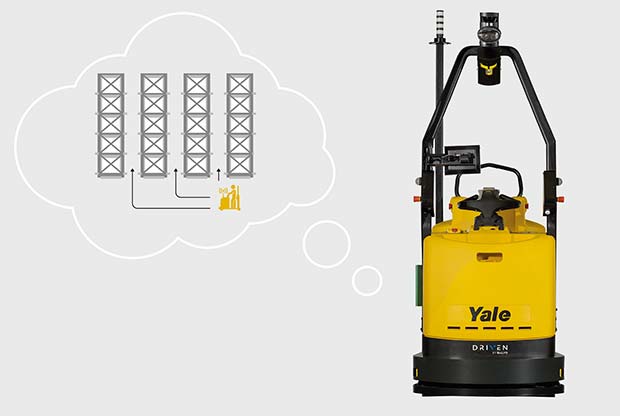It’s an age-old question in materials handling: how do operations increase productivity while driving down costs?For many industries, the introduction of robotics offers a worthy return on investment.
 Justifying the investment
Justifying the investment
Automated materials handling equipment has historically been bespoke, complex and inevitably expensive, to both purchase and install. The result is an inflexible solution that is unable to adapt to new or altered operating environments. Today, robotic lift trucks can operate without any added infrastructure and are unrestricted by fixed routes. This offers great strides forward in terms of flexibility, ease of use and productivity. For example, Yale® robotic lift trucks, driven by Balyo technology, build a map of the facility and self-locate in real time, navigating without the need for any dedicated physical infrastructure and responding to unexpected obstructions quickly and easily.
As the competitive landscape continues to intensify, materials handling operations cannot afford an investment that does not pay off, so translating these benefits from theoretical to tangible reality is key. The business climate also requires a reasonably fast return on investment (ROI). The more shifts an operation runs, the sooner they can reap a full return on their robotic lift truck investment – oftentimes less than two years for two- or three-shift operations.
Reduced turnover and training time
High turnover rates for warehouse workers and the cost of filling newly vacant positions places operations under pressure. While training periods for new employees can vary based on the nature of the job, one thing remains constant – training inexperienced or unskilled employees is costly.
Adopting automated transportation solutions like robotic trucks can help simplify tasks reserved for employees. For example, in goods-to-operator fulfillment workflows, employees do not need to know the storage location for inventory required for each order; they can focus on picking and packing orders as quickly as possible from the inventory brought to them by a robotic solution.
Implementing robotic equipment does not take away high-value jobs from operators. Instead, using automated solutions can help managers address the labour shortage and free employees to advance to more engaging, meaningful positions – helping curb turnover.
 Increased uptime and productivity
Increased uptime and productivity
Supply chain operations are under increasing pressure to get more done in less time with fewer resources. SKU proliferation and the desire for faster delivery times add further complexity and have defined a new “normal.” Services that were once considered perks, like free two-day shipping, are now an expectation for every ecommerce order.
This demand triggers a radical shift in operations, with shorter delivery times becoming a driving factor for warehouse overhaul. In this environment, businesses have zero tolerance for downtime, and even minor interruptions can have a severe financial impact.
Automation is a reliable solution to minimise the risk of downtime and unexpected delays. A robotic truck does not need to take time off; it works relentlessly 24/7 and only stops for battery replacement. Robotic solutions are designed to follow the rules of the road, reducing downtime resulting from impacts and interruptions, and improving equipment longevity.
When it comes to bringing out the best in employees, introducing robotics can help foster a collaborative environment with operators working alongside robotic equipment, where the strengths of both are leveraged to make repetitive tasks and more complex, value-added functions more efficient. This can provide new opportunities for people with physical limitations, like limited mobility, to serve as integral parts of certain processes, such as using automated systems to move inventory to pickers, helping keep throughput flowing.
Efficient route planning and adjustment
Introducing robotic equipment into a facility starts with walking the truck through the space to build a map and learn the main routes, storage aisles and other characteristics. The robotic software uses this information to find the most efficient routes and responds in real time to obstructions and shifting traffic volumes, converting to alternative paths as needed.
For example, if one robotic truck encounters a delay-causing obstruction, it can inform other units so they can find alternate routes. This is a huge leap from traditional AGVs, which were not only restricted by extra navigation infrastructure, but also lacked on-board intelligence, leading them to simply stop in the event of an obstruction and bring throughput to a halt.
Modern infrastructure free navigation and route planning intelligence enables robotic lift trucks to easily adapt to layout adjustments, as operations accommodate changing inventories and workflows. This also helps meet sustainability goals. Units traveling along the most efficient routes from point A to point B can minimise energy usage. Efficient routes and coordination between robotic trucks also balances the flow of traffic, minimising congestion that causes unexpected delays and downstream issues like missed shipments.
Higher efficiency, lower costs The use of robotic trucks allows operations to perform repetitive tasks such as movement of pallets in the warehouse environment, and loading and unloading in a more cost effective way – saving valuable time and money.
Not only will they improve productivity, picking up, transporting and dropping off pallets independently and reliably, an automated operation may also aid in reducing product damage and accidents by safeguarding against operator error. Compared to traditional AGVs, robotic equipment also offers significant cost savings when it comes to unexpected service and routine maintenance. Since they are simply standard lift trucks with robotic technology added, the same local dealer personnel can provide service without the downtime and expenses that come with specialsed technical resources.
Real-time truck management
The Industrial Internet of Things (IIoT) has already changed the way people do business, revealing new opportunities for improved productivity and profitability.
Interfacing robotic lift truck management software with a WMS or ERP system enables valuable communication to connect data points and make real-time adjustments.
Combined with telematics systems, such as Yale Vision, robotic trucks offer unparalleled visibility into overall processes and individual units, enabling adjustment and ongoing optimisation based on usage, congestion, maintenance and other data. For example, operations can adjust fleet size and composition to ensure the best configuration for their needs, while coordination among software systems can enable robotic trucks to proactively acknowledge required battery replacements or preventive service.
Navigate your way to greater efficiency with Yale
Based on existing manual equipment the Yale robotic MO25 low level order picker, MO50-70T tow tractor and MC10-15 counterbalance stacker is suitable for a wide range of applications. The trucks can automate a variety of repetitive load transportation tasks from servicing production lines, transporting loads between stations, and conducting ‘milk-run’ production loops to carrying empty pallets to a palletising machine, while offering the familiarity, reliability and durability of the Yale brand.
Built-in advanced obstacle detection helps the equipment anticipate and react to their immediate environment, controlling truck speed and allowing for smooth, efficient movement. While the provision of both manual and automated modes ensures efficient operation alongside employees and manually operated trucks.
The dual-mode design means Yale robotic trucks can still be used manually to complete non-automated tasks. Operators can regain control at the touch of a button, eliminating the need for separate equipment and gives customers the flexibility to accomodate unexpected requirements.
The industry experts at Yale have carefully studied how to make robotics as costeffective and productive as possible for materials handling operations. The Yale robotics solution is completely scalable from a single truck to a large fleet to ideally suit the application at hand. As the Industry 4.0 trend continues, Yale robotics can open the door to automation to many who were unable to consider it in other iterations.
YALE
01276 538500




Comments are closed.